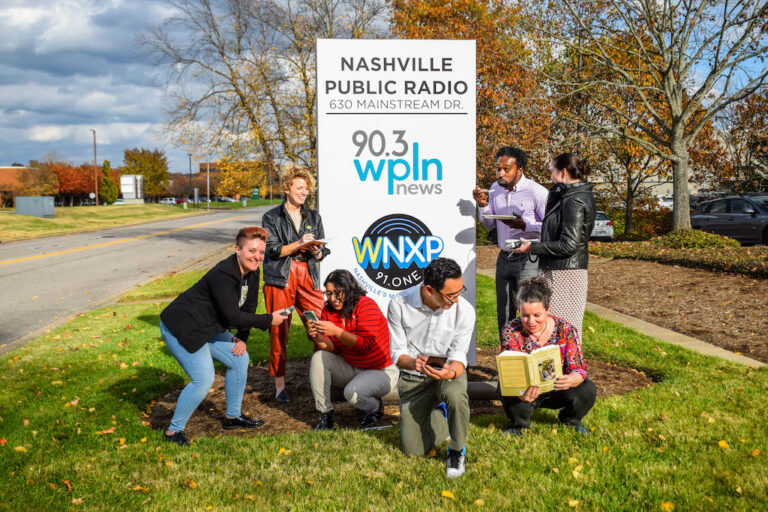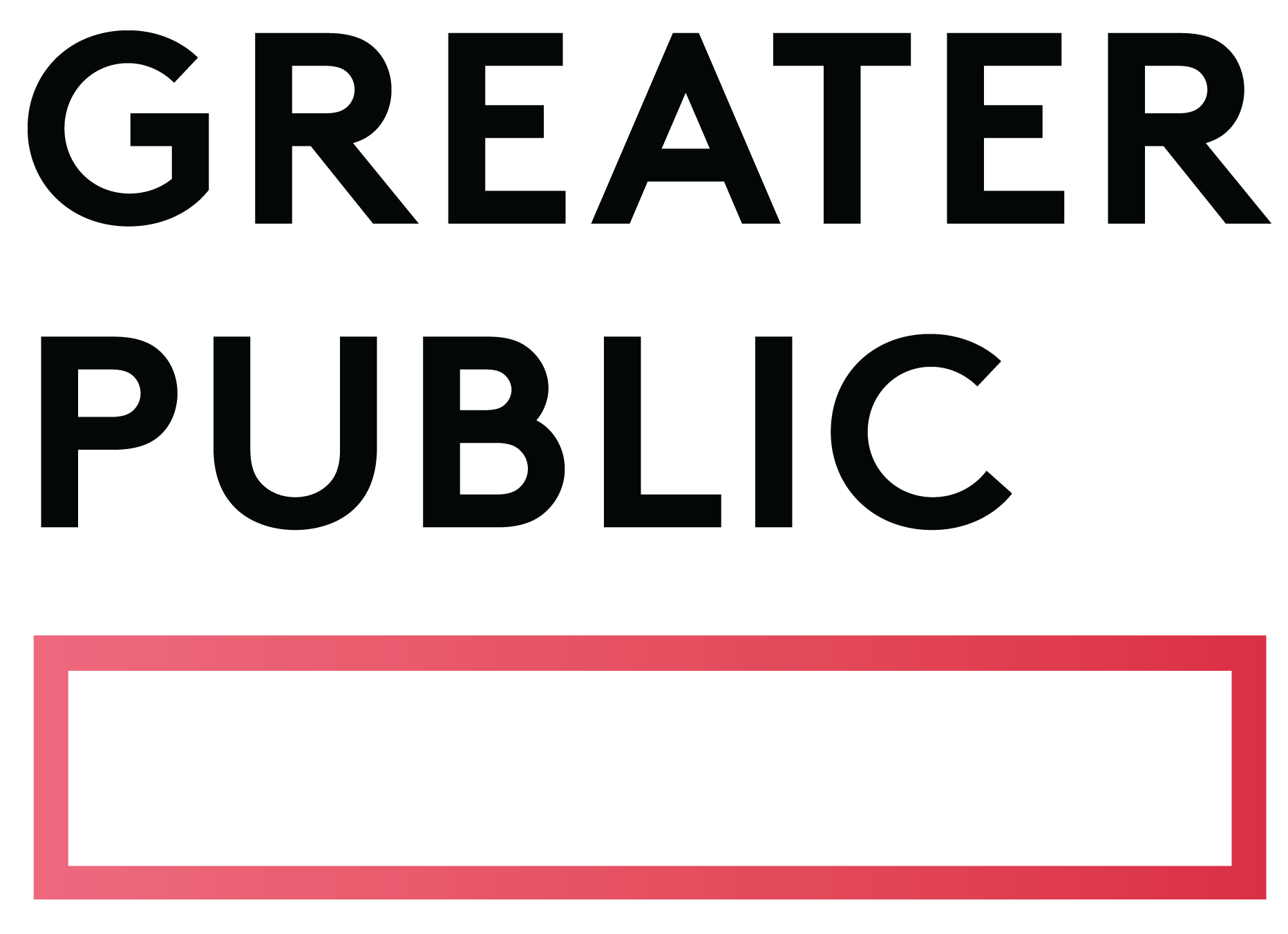Related Articles
Subscribe to the Greater Public newsletter to stay updated.
This site is protected by reCAPTCHA and the Google Privacy Policy and Terms of Service apply.

The staff of “This Is Nashville” outside of the WPLN News studio. From left: Mikayla Elias, Andrea Tudhope, Anna Gallegos-Cannon, Steve Haruch, Khalil Ekulona, Tasha Lemley and Rose Gilbert.
A version of this article was originally published in Current on May 9, 2022 following Nashville Public Radio President and CEO Steve Swenson’s participation in the leadership roundtable conversation “Moving Beyond Preservation to Innovation” as part of the Audience Development Summit.
Nashville Public Radio board member Curt Thorne believed his city needed more from its public radio station.
In 2018, while serving as chair of the board’s search committee for the station’s next president, he and his fellow board members had concluded that it was time to expand the station’s service.
“Nashville has been growing rapidly,” Thorne explains. “The rate of growth of [Nashville Public Radio] membership was not reflective of the rate of growth of our population. We identified that we had a big opportunity.”
Nashville’s population has grown by more than 2% every single year since 1991. When the board started their search, the station was serving a market of nearly 2 million people with 25 full-time employees. The board believed Nashville Public Radio had a public service mandate to do better.
“The big driver was our imperative to fill the breach left by the exit of for-profit media,” Thorne adds. “At the local level, public radio is arguably the last chance for fulfilling the need for independent media in a functioning democracy.”
In 2019 veteran CBS Radio executive Steve Swenson was hired as president and CEO of Nashville Public Radio, which included oversight of WPLN News and 91Classical. In just three years the WPLN newsroom nearly tripled in size and 91Classical converted its format to triple-A. The changes have produced more local journalism for the region, and are part of a larger strategy by the station to attract a greater segment of the Nashville audience. They’ve doubled the size and greatly increased the diversity of the organization itself, which Swenson feels is essential to create the public service needed in the region.
“We were a primarily white organization living in Nashville,” Swenson says. In Davidson County, where Nashville is the county seat, 45% of residents identify as BIPOC, according to the 2020 census. In 2019, just 15% of the station’s staff identified as BIPOC. “We did not have voices inside [the organization] that we were supposed to be serving [in the community],” he adds.
After obtaining research about where opportunity lay for growth, Nashville Public Radio made its first major change in late 2020 by replacing the classical format on 91.1 FM with Triple-A music.
“Our classical [format] was losing revenue every year and we made a decision that we as an organization couldn’t afford for that to be the case,” Swenson explains.
The launch of WNXP included the addition of five new staff positions and was partially funded by annual commitments from about a dozen founding members and sponsors. Initial concerns about financial losses from the switch have abated as WNXP has doubled its corporate support revenue in the first year. Audience growth for the service hasn’t caught up to the revenue gains, but this wasn’t entirely surprising given the limitations presented by persistent pandemic lockdowns.
“It started off slow with audience,” Swenson says. WNXP is targeting Nashvillians ages 18-49. But the audience it can draw from existing channels are 45+ from the former 91Classical and 25-54 from WPLN News.
“As the world is reopening and people are getting back in their cars, they are finding [WNXP],” he concludes. “We’ve found growth in 25-34 year-olds every single month of the past five months. We think things are catching on.”
Another idea for audience growth was something Swenson brought to the board in their earliest conversations: the launch of a one-hour daily news program on WPLN News. A strong local news presence is a common anchor in similarly-sized markets, but was noticeably absent in Nashville.
“We had three hours of National Public Radio content during morning drive and evening drive, and the only locally-produced content people were hearing were short segments,” Swenson recalls. A daily local news program would help to increase appointment listening, and in turn boost corporate support revenues and time spent listening, which drives membership gains.
However, Anita Bugg, Nashville Public Radio VP of content, advised against launching a daily show without first growing the newsroom’s ability to provide the show with content.
Neither Swenson nor Bugg wanted a new show to be “just a host and producer, and long-form interviews,” Swenson recalls. Instead, “it would be an opportunity for our journalists to showcase their journalism.”
So from 2019 to 2021, the WPLN newsroom grew from eight staff, including one reporter who covers health care and another assigned to state politics, to a staff of 26. The number of reporting beats has expanded to include education; criminal justice; the environment; metro government; and music, arts and culture.
The new beats are supported by a combination of corporate and foundation support, along with a major gift from a family trust. A portion of newsroom operations were funded by Nashville Public Radio’s endowment, and the station took advantage of the long lead-up to the show’s creation to save money for its launch. As the staff was growing, WPLN News hosts began to talk on-air about the desire to launch the new program. That messaging led at least one foundation to inquire about supporting the effort, Swenson reports.
WPLN News hired key staff for This Is Nashville last summer. Executive Producer Andrea Tudhope arrived from Kansas City, Mo., and Host Khalil Ekulona came from KUMN in Albuquerque, N.M. The pair spent their first seven months conducting interviews to better understand issues in the Nashville region. They also solicited feedback from community members, many of whom were unfamiliar with or uninterested in Nashville Public Radio, to inform how the show delivers on its mission to be “driven by community, for community.”
Through a survey, in-person meetups, a community focus group and a virtual listening session, participants said they wanted media coverage that highlights shared values and the ways in which multiple groups contribute to the community, Tudhope said. Many asked for coverage that would “help all of our various neighborhoods feel more connected as one city.”
Since its debut in early March, This Is Nashville has produced programs about nurses suffering from burnout during the pandemic, “navigating Nashville when you have a disability” and Black country music.
To create a team that intentionally represents “old” and “new” Nashville, Tudhope and Ekulona hired five additional staff who already lived in the city. Having that tension within the staff allows the team to be in touch with how that dynamic plays out in the community and create coverage that bridges those experiences, Swenson says.
The show team also reflects a shift in the diversity of Nashville Public Radio’s staff overall, which is now 35% BIPOC. Nearly half of the station’s on-air voices identify as BIPOC.
“We are a dramatically younger organization,” Swenson observes. “Most of the new people we’ve hired are probably in their 20s or 30s. That has been energizing for the organization.”
But with growth come challenges. Many of the staff changes have occurred in a remote work environment. As employees come back into the office, or join colleagues in-person for the first time, they’re finding a different organizational culture, and one that’s still in the throes of change.
“I realized some years ago that I like change and not everyone does,” Swenson explains. “I see myself as a change agent and I realize that means you have to work hard to bring everyone along. Sometimes you need to prod a little bit to help people get there, and sometimes you need to chill a little bit. Just as we talk about our mission to the public, we need to talk about it internally too. People do get it.”
Nashville Public Radio retained Culture Shift Team, a consultancy specializing in multicultural marketing and DEI education and strategy, to train staff on how to have constructive conversations and build the skills to address conflict when it arises. A homogeneous staff often shares cultural values and assumptions. If a diversified staff doesn’t value difference and can’t share decision-making, it can be difficult to retain staff – and the audiences they represent – who feel unheard and unvalued.
“It’s hard work for everyone – for employees, for leadership. It’s hard.” Swenson emphasizes. But the plans for growth have not subsided.
For the next phase of its audience development process, Nashville Public Radio plans to build out strategies for marketing and events. And in the fall, staff and leadership will begin working with Poynter Institute’s Digital Transformation Program.
As its growth and diversification continues, the organization is grappling with the demographic shifts and cultural changes that many public media stations face.
These changes can feel scary, Swenson acknowledges, adding, “We needed to help our culture be less risk-averse and less fearful of trying new things.”

View these related member resources and more with a Greater Public membership:
This site is protected by reCAPTCHA and the Google Privacy Policy and Terms of Service apply.
New to Greater Public? Create an account.
